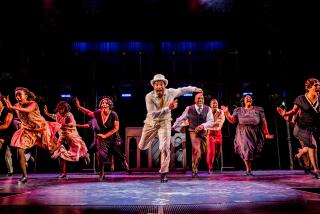ALL-ARPINO PROGRAM : JOFFREY PIZAZZ IN ‘JAMBOREE’
Gerald Arpino, associate director of the Joffrey Ballet, may not be the most original choreographer in the world. He may not command the most probing of aesthetic intellects or the loftiest of expressive sensibilities. But, by gumbo, he knows how to please an audience.
According to the Music Center playbill, he is the only choreographer to have had four of his ballets performed at the White House. That must mean something. I’m not sure what, but something.
Even at his most pretentious, Arpino is a splendid craftsman. He understands his dancers and savors the devices that will make them look athletically dramatic, not to mention dramatically athletic.
He is a classicist who embraces all--well, almost all--that is trendy and/or instantly accessible. He is resourceful, adaptable, energetic, clever.
For better or worse, he is the epitomical show-biz choreographer.
For two thirds of the all-Arpino bill staged by the Joffrey at the Dorothy Chandler Pavilion Wednesday, it was for better. The unhappy third came in the middle, with a reprise of “Round of Angels.”
This, you will recall, is the 1983 kitsch extravaganza that trivializes the Adagietto from Mahler’s Fifth Symphony with a would-be ethereal Patricia Miller swooping and swooning in midair, supported and manipulated by six muscular heroes, while Christmas-tree lights blink a celestial benediction on the cyclorama.
Arpino set his sights somewhat lower, thank goodness, in “Kettentanz,” which opened the program with a big dollop of Viennese Schlag sweetened with saccharin, and in “Jamboree,” which closed the program with a happy orgy of Texas-style razzle-dazzle.
“Kettentanz,” or, if you will, “Chain Dance,” dates back to the innocent days of 1971. Utilizing a collection of quaint and elderly galops, polkas and waltzes--nine by Johann Strauss Sr., one by Johann Mayer--Arpino cranks out a long half hour of sprightly set pieces that fuse caractere convention with bravura invention.
His young dancers sometimes have to substitute New World enthusiasm for Old World finesse. Fortunately, the enthusiasm is infectious, and when the sparks really ignite--as they do in the competitive antics of two inspired mini-ballerinos, Mark Goldweber and David Palmer--the ballet isn’t just cute. It is exhilarating.
The anything-you-can-do-I-can-do-faster duet returns, after a fashion, in “Jamboree,” a splashy ode to the city of San Antonio that received its premiere--guess where--last June. Arpino is not a choreographer prone to leaving well enough alone. In this incarnation, the twinkle-toe boys--Palmer and Tom Mossbrucker--are 19th-Century cowboy twins who court, and win, the masses to the tune of “Split Rail.”
Essentially, “Jamboree” is a historic pastiche that looks folksy but dances fancy. Very fancy.
Arpino remembers a storybook Alamo in which Edward Morgan can strut his stuff with equal parts pride and pizazz, in which Patricia Miller and James Canfield can turn a Hispanic prayer into a languidly sensual duet, in which Jodie Gates and Glenn Edgerton can slink and kick their heels in elegant Riverwalk unison.
One can argue that the Guadalupe Passion Play episode, with Patricia Miller as a flower-strewing Madonna statue and Luis Perez as a quiveringly repentent sinner, teeters on the brink of the tawdry. There is fun, however, in a rousing and marvelously eclectic finale that seems to pay simultaneous homage to the Virginia reel, Americana with the accents of De Mille and Loring, well-schooled “Giselle” peasants and any number of chorus lines.
The Joffrey kids make the most of it.
Teo Macero’s Tex-Mex score, which combines live orchestral utterances with taped devices, treads a narrow line between the charming and the vulgar. Sometimes it transgresses toward the vulgar. Brad Braune’s front curtain, a cozy vista of longhorn cattle, cowhands and cactus, invokes the Old West sweetly. Willa Kim’s period costumes and Thomas Skelton’s lighting sustain the proper picturesque mood.
More to Read
The biggest entertainment stories
Get our big stories about Hollywood, film, television, music, arts, culture and more right in your inbox as soon as they publish.
You may occasionally receive promotional content from the Los Angeles Times.










